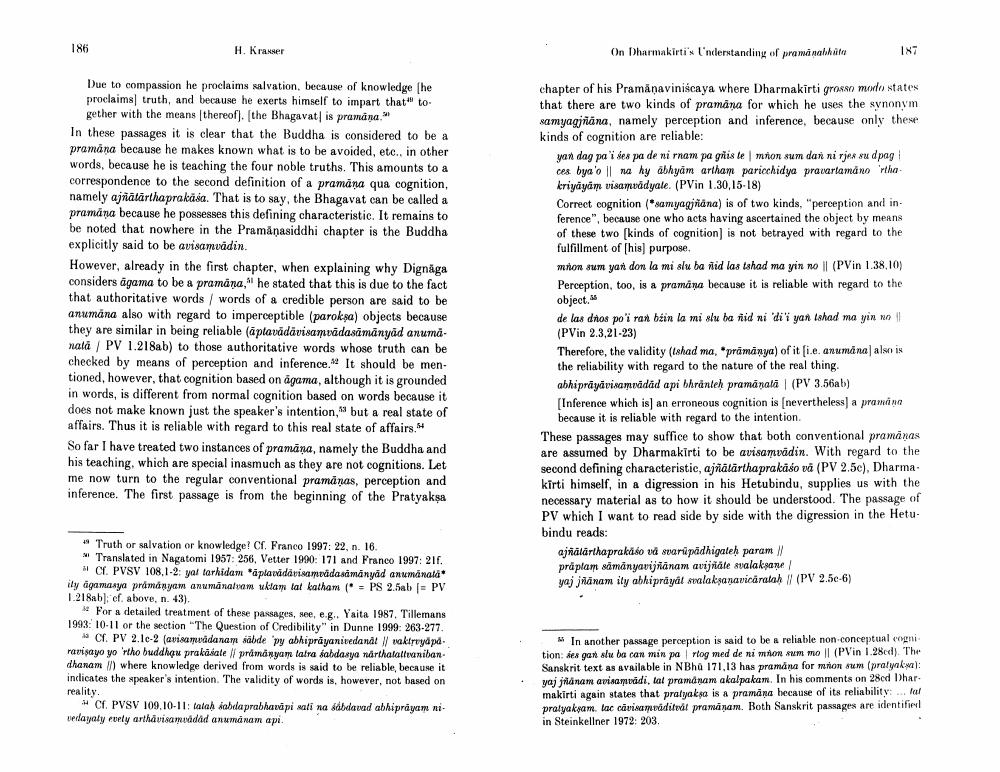Book Title: On Dharmakirtisunderstanding Of Pramanabhuta And His Definition Of Pramana Author(s): Helmut Krasser Publisher: Helmut Krasser View full book textPage 8
________________ 186 H. Kraker On Dharmakirtis 'nderstanding of pramanashifu 187 Due to compassion he proclaims salvation, because of knowledge she proclaims truth, and because he exerts himself to impart that" to gether with the means thereof). [the Bhagavat is pramana." In these passages it is clear that the Buddha is considered to be a pramana because he makes known what is to be avoided, etc., in other words, because he is teaching the four noble truths. This amounts to a correspondence to the second definition of a pramana qua cognition, namely ajátarthaprakáša. That is to say, the Bhagavat can be called a pramana because he possesses this defining characteristic. It remains to be noted that nowhere in the Pramanasiddhi chapter is the Buddha explicitly said to be avisamvadin. However, already in the first chapter, when explaining why Dignaga considers agama to be a pramana," he stated that this is due to the fact that authoritative words / words of a credible person are said to be anumana also with regard to imperceptible (paroksa) objects because they are similar in being reliable (aptavādāvisamadasāmānyäd anuma. nala / PV 1.218ab) to those authoritative words whose truth can be checked by means of perception and inference. It should be men. tioned, however, that cognition based on agama, although it is grounded in words, is different from normal cognition based on words because it does not make known just the speaker's intention, but a real state of affairs. Thus it is reliable with regard to this real state of affairs. So far I have treated two instances of pramāna, namely the Buddha and his teaching, which are special inasmuch as they are not cognitions. Let me now turn to the regular conventional pramanas, perception and inference. The first passage is from the beginning of the Pratyaksa chapter of his Pramanaviniscaya where Dharmakirti grosso modo states that there are two kinds of pramana for which he uses the synonym samyagilana, namely perception and inference, because only thene kinds of cognition are reliable: yan dag pa de pa de ni rnam pa gris temton sum dan nirjan su dpagi ces bys'o il ne ky ábhyam arthane paricchidya pravartamd northe kriyayam visamádyale. (PVin 1.30,15-18) Correct cognition (samyagjina) is of two kinds, "perception and inference", because one who acts having ascertained the object by means of these two kinds of cognition) is not betrayed with regard to the fulfillment of Chis) purpose. minon sum yan don la mislu barid las tahad ma yini no (PVin 1.38,10) Perception, too, is a pramana because it is reliable with regard to the object. de las dros poi rart búin la misluba siid ni 'di'i yan tahad ma yin no (PVin 2.3,21-23) Therefore, the validity (Inhad ma, "prāmánya) of it sie anuminaalis the reliability with regard to the nature of the real thing. abhipriyavisamnidad api bhranteh pramanala (PV3.56ab) [Inference which is an erroneous cognition is nevertheless a promana because it is reliable with regard to the intention These passages may suffice to show that both conventional promanas are assumed by Dharmakirti to be avisamvadin. With regard to the second defining characteristic, ajátarthaprakaso ni (PV 2.5e), Dharmakirti himself, in a digression in his Hetubindu, supplies us with the necessary material as to how it should be understood. The passage of PV which I want to read side by side with the digression in the Hetubindu reads: ajratarthaprakaso vd saripadhigateh param praplan samanyarijanam avijte malakxane yaj janam ily abhiprayat svalakrasavicäratah (PV 2.5e-6) * Truth or salvation or knowledge! Cf. Franco 1997: 22, n. 16. Translated in Nagatomi 1957: 256, Vetter 1900: 171 and Franeo 1997: 211 # C, PVSV 108,1-2 yal tarkidam aplaudarimuddasimanyád animali ily agamasya pramanyam anumanayam wktam lat katham (* = PS 2.5ab [= PV 1.218ab); cf. above, n. 43). For a detailed treatment of these passages, see, eg.. Yaita 1987. Tillemans 1993: 10-11 or the section "The Question of Credibility in Dunne 1999: 263-277. C. PV 2.10-2 (avisamwadanam sābde 'py abhiprayanivedanál // wakirudd ravisayo yo rtho buddhau prakdale il pramanyamelala faldasye rarthalattuaniban. dhanam ) where knowledge derived from words is said to be reliable, because it indicates the speaker's intention. The validity of words is, however, not based on reality. 4 Cr PVSV 109,10-11: talah sabdaprabhavapisali na iddaad abhiprayam ni vedayaly cely artha Visa mindad anumanam api In another passage perception is said to be a reliable non conceptual cogni tion: des gan alu ba can min parlog med de ni mion rummo (PVin 1.28ed) The Sanskrit text as available in NBho 171,13 has pramana for min sm (pralyka: yaj janam avisamudi, tai pramdam akalpakam. In his comments on 28ed Dhar. makirti again states that pratyaka is a pramana because of its reliability...al pratyakam tac crime raditrdil promasam. Both Sanskrit passages are identified in Steinkellner 1972: 203Page Navigation
1 ... 6 7 8 9 10 11 12 13 14
